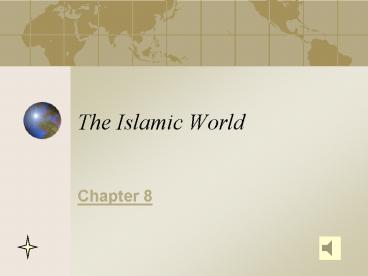The Islamic World PowerPoint PPT Presentation
1 / 31
Title: The Islamic World
1
The Islamic World
- Chapter 8
2
Quiz
- All Muslims are Arabs.
- All Arabs are Muslim.
3
Muhammads Arabia
- Bedouin hunter-gathers
- Military power/ influence
- Horsemen
- Social unit tribe
- Patrilineal
- Protection/support
- Religion polytheistic
- Nomads caravans
- Semi-nomadic farmers
- Warrior elites
4
Islamic Doctrine
- Five Pillars of Islam
- Quran
- Profession of faith
- Pray five times a day
- Pilgrimage to Mecca hajj
- Alms to Muslim poor
5
Beginnings of Islam
- Hijra the flight or the migration 622 C.E.
- Mecca Medina
- Returns 630
- Dies - 632
6
(No Transcript)
7
Kaba
The base of the Ka'ba is 10.5 x 12 meters, and
it's 15 meters high, and is standing on a marble
base, 25 cm high. Corners are pointing in the
four directions of the compass. It is built of
grey stones from the hills around Mecca. The
floor is covered by marble, and there is no
furniture, except gold and silver lamps.
8
Inside a mosque, men praying
9
Leadership
- Caliphate
- Religious teachings are law
- Interpreter of the law
- Abu Bakr elected
- Umar
- Uthman
- Ali assassinated by Muawiya
10
The Division
- Two groups
- Sunni
- Umma - practices
- Shiite
- Followers of Ali
- Rightful successor
- Authority in
- Quran
- Sunna sayings and ideas of Mohammad
11
- Difference
- Sunni
- Ulama interpretation of Quran
- Shiite
- Imam interprets Quran
12
Umayyad
- 661- 760
- Muawiya capital to Damascus
- No government bureaucracy personal connections
- Political and military leadership
13
Umayyad Dynasty
- The Umayyad Dynasty (661-750)
- System of succession became dynastic
- Shiites
- Sunni
- Moved capital to Damascus
- Continued to move east and west
14
Umayyads
15
The Abbasid Dynasty (750-1260)
- Opened faith to all comers on a basically equal
basis - Administration brought in foreign modes of
government - Empire too large - areas became independent
- Muslim faith binds Muslim world culturally and
religiously - umma
16
The Abbasid Caliphate at the Height of Its Power
17
Abbasid Caliphate
- Baghdad became cultural center
- Governing powers exercised by Persian bureaucracy
- Vizier
- Emir
- Ulama
- sharia
- Diwan
- Qadi
- Muslims sacred book remained basis for all laws
- Muslim army very international in flavor
18
Conversion to Islam
- Conversion - special allowance to conquered
people - No effort made to convert peasants or urban
population - Intermarriage between Muslim and non-Muslim
prohibited - Viewed different groups differently
- Dhimmis
- Not taxed severely as other groups
19
- Everyday Affairs
- In the beginning, minority of population
- Used conquered infidels to the everyday tasks
of life - Conquered subjects could hold not high level
offices - Definite social pyramid
- Religion truly decisive factor in Muslim society
20
Spread of Islam
21
Islamic Society and Institutions
- Created a cultural matrix - blended
- Now occupied place once held by Greece and Rome
- Infused by conquers from Mongolia and Ottoman
Turks - Culture elements held people together
22
Literature and Education
- Literature
- Arabic language important source of unification
in Muslim world - Paper factory in Baghdad as early as 793
- University also a Muslim creation - Madrasa
- University of Cairo oldest functioning university
- Founded 9th century
- Teachers - basis of character and intellect
- Memorization of Quran
- Education goal to live according to Allahs law
23
Sciences
- Greeks theoretical, Muslims practical
- Between 800 and 1200 ahead of West
- Geography
- Pharmacology
- Expanded Hindu system - Arabic numerals
- Introduced algebra and decimal system to west
- Astronomy
- Ibn Sina - (Avicenna) - medicine
- Ibn Rushd commentary on Aristotle
24
- The Arts in the Muslim World
- Geometrically based art instead
- Lasting forms of beauty in architecture
- Calligraphy was a strength of Muslims
- Arabs developed storytelling to an art
- Harun al-Rashid - Caliph
- The 1001 Nights also called The Arabian Nights
25
Islamic Art
26
Interior of Blue Mosque. Located in Istanbul,
Turkey
27
Ceiling of Mihrab Chapel. Located in mosque at
Cordoba, Spain
28
Sufi
- Ninth and Tenth Centuries
- Suf - course garments
- Rejected materialism
- Ascetic lifestyle
- Prayer
- Fasting
- Meditation on Quran
- Accepted ideas from Buddhism, Hinduism,
Christianity - Ulema declared them heretics
29
- Social Customs Marriage and the Status of Women
- Allowed but not encouraged to marry up to four
wives - Many household kept one slave
- Household ruled by the man
- Harem
- Women not to be seen or heard outside of the
house
30
Spread of Islam
31
Summary
- Islam and Arabs not synonymous
- Islam Muhammad
- Culture change for Arabia
- After Muhammad
- Leadership role division
- Religion to political effort
- Spread by conversion and conquest

